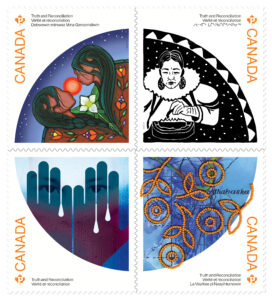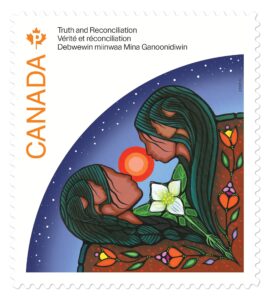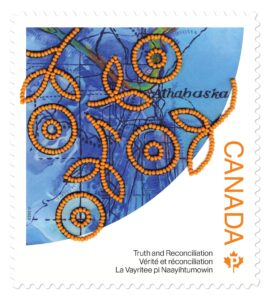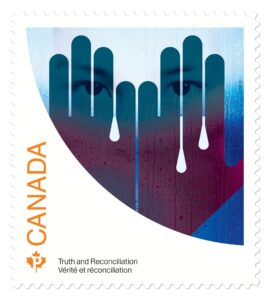Canada Post is releasing four stamps “to encourage awareness and reflection on the tragic legacy of Indian residential schools and the need for healing and reconciliation.” The stamps are being released to recognize the National Day for Truth and Reconciliation on Sept. 30.
Canada Post said this will be the first in an annual series showcasing the visions of First Nations, Inuit and Métis artists for the future of truth and reconciliation.

Canada Post is releasing four new stamps in connection with the National Day for Truth and Reconciliation on Sept. 30. This is the first in an annual series showcasing the visions of First Nations, Inuit and Métis artists for the future of truth and reconciliation.
In a statement, Canada Post said between the 1830s and 1990s, more than 150,000 First Nations, Inuit and Métis children across Canada were taken from their families and sent to federally created Indian residential schools. They were stripped of their languages, cultures and traditions. Children endured unsafe conditions, disease, and physical, sexual and emotional abuse while at the church-run schools. Thousands of them never made it home. Residential school Survivors continue to experience trauma from their time at the institutions, and that has been passed down to successive generations.
Canada Post said the four-stamp issue “will help Canadians reflect on the injustices and trauma that have been inflicted on generations of First Nations, Inuit and Métis Peoples and calls attention to the responsibility all Canadians have in reconciliation.”
The stamps are cancelled in Brantford, Ontario, the site of the Mohawk Institute, whose opening in the early 1830s made it Canada’s first Indian residential school. The Indigenous languages found on the stamps represent the language and dialect of the artists who created the work.
Below is a description of each stamp and a brief bio on each artist.
Jackie Traverse, First Nations artist (Lake St. Martin, Manitoba) – Anishinaabe, Ojibwe
“This image represents seeds of change. Here we have man and woman, the Elders, their children and their grandchildren. I’ve put the (unofficial) national flower, the bunchberry, in the centre to represent Canada, with the roots from the seeds reaching to the past. For all of us to experience a good harvest we need to share the sun, water and the land. This is how we bring forth good crops and ensure everyone has the harvest of tomorrow.”
Traverse’s mother died at a young age and her siblings were apprehended in the Sixties Scoop. She grew up in one of Winnipeg’s toughest neighbourhoods. Traverse is a multi-disciplined Indigenous artist who works in several media, from oil and acrylic paintings to mixed media, stop-motion animation and sculpture. She draws inspiration from her Indigenous culture and her experiences as an Indigenous woman living in Winnipeg. Her work speaks to the realities of being an Indigenous woman.
Gayle Uyagaqi Kabloona, Inuit artist – Qamani’tuaq (Baker Lake), Nunavut
“I believe each group within Canada has a different responsibility for reconciliation. For Indigenous People, our responsibility is to ourselves and to others within our communities: learning or passing on our language and culture that was attacked only one generation ago. I created a woman lighting a qulliq (QUL-liq), the traditional Inuit stone lamp used for heat and light to signify caretaking. This woman is carrying on in her culture as she has always done, taking care of herself and others and healing.”
Originally from Baker Lake, Nunavut, Kabloona comes from a family of renowned Inuit artists. Art is how she connects with others within her culture, showcases her Inuit heritage, and expresses her Indigenous identity. Kabloona’s work puts a modern take on traditional Inuit imagery, and strong women frequently make appearances in her art. She co-founded a small group ceramics studio and has taught art as therapy at an addictions healing centre for Inuit, located in Ottawa. Last year, Kabloona was awarded a residency at the Art Gallery of Guelph, working with an Inuit curator, and created a new piece to be shown alongside her grandmother’s and great-grandmother’s artwork from the gallery’s collection.
Kim Gullion Stewart, Métis artist – Athabasca, Alberta (currently lives in Pinantan Lake, British Columbia)
“Flowers in Métis art remind people to live in a symbiotic way with land, waterways, ecosystems and one another. In this piece I have placed beaded flowers on top of contour lines representing the Rocky Mountains, twisty lines for rivers and dashes demarking political territories. While maps like this one are a two-dimensional record of historical process and places, they are incomplete until they include elements that are important to the people who are Indigenous on this continent.”
Gullion Stewart was born in Athabasca, Alberta. Her father’s heritage connects her to the Métis homeland of Red River, Man. She creates metaphorical meaning by connecting Métis cultural art forms (hide tanning, beading, quillwork) with contemporary and graphic art forms. In her art, she searches to uncover the depths of her Métis identity and learn Métis knowledge systems that have been hidden, lost or adapted as a survival mechanism. She is inspired by what Métis leader Louis Riel (1844-85) once said: “My people will sleep for 100 years, but when they awake it will be the artists who give them their spirit back.”
Blair Thomson, artist and graphic designer
“A pair of bold hands are held over the eyes and human face. Intended to be cross-representative — those of Indigenous Peoples/Survivors, covering their face in sadness, pain, memories, and those of the settler, masking their view of reality and shame. Tears stream from between the fingers. The background further connects to the school windows, looking out and dreaming of home. The eyes looking out from behind the hands reinforce the message that settlers must ‘never look away again.’”
Thomson is founder and creative director of Believe in, a design practice with studios in Canada and the United Kingdom. A harmony between strategic foundation, unique ideas and beautiful outcomes lies at the heart of his approach and creative processes. His work is multi-award winning and has been featured in many leading design publications worldwide. Thomson is the collector, archivist and historian responsible for Canada Modern (an archive of modernist, Canadian graphic design from 1960-85).
For more details, visit canadapost.ca
